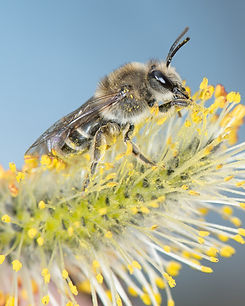
Family Megachilidae > Genus Chelostoma
Chelostoma
Scissor Bees
In Minnesota, there is one described species within the genus Chelostoma—Chelostoma philadelphi, a pollen specialist (oligolege) of Philadelphus (mock-orange). Given that mock-orange is not native to Minnesota, this species likely expanded its range into the state when homowners began planting its pollen host plant. Chelostoma philadelphi constructs solitary nests in abandoned beetle tunnels in dead wood.
Females collect pollen on hairs on the underside of their abdomen, and have a square head and large mandbiles. Both females and males have a narrow linear form, dark gray or black integument, and an elongated thorax with the wings attached farther back than typical of other bees. Chelostoma philadelphi ranges in length from 6 to 8 mm (0.23 to 0.35 inches) and females are slighter larger than males.

Chelostoma philadelphi male visiting Viola canadensis.

wing
position
on flowers

N0. species in MN
1
size range

Phenology

Genus/Species Characteristics

Females collect pollen on hairs on the underside of their abdomen.
female

Linear form; dark gray or black integument; wings attach to middle of thorax (set back).
male

female
Females with square head and dark gray or black integument; wings attach to middle of thorax (set back).

female
Females with large mandibles.
Distribution


Regional Map
Chelostoma philadelphi (Robertson, 1891) in GBIF Secretariat (2023). GBIF Backbone Taxonomy. Checklist dataset https://doi.org/10.15468/39omei accessed via GBIF.org on 2024-12-20.
Plant
Associations
Females are pollen specialists of Philadelphus (mock-orange) but will visit other flowering plants for nectar such as fleabane. In Minnesota, males have been observed visiting:
Viola canadensis
(Canada violet)
Geranium maculatum
(wild geranium)
Erigeron spp.
(fleabane)




Explore More Megachilidae Genera
Note: Two genera/species on the state list are not included in this guide: Ashmeadiella bucconis (last seen in Minnesota in 1949) and Trachusa zebrata (last seen in Minnesota in 1939). If either of these species is rediscovered in the state, they will be added to the guide at that time.
Explore Bee Families

Apidae
15 genera, 133 species
Bumble bees Bombus
Longhorn bees
Epimelissodes, Eucera, Melissodes
Carpenter bees
Ceratina, Xylocopa
Honey bees Apis
Digger bees Anthophora
Cuckoo bees Brachymelecta, Epeolus, Holcopasites, Nomada, Neolarra, Triepeolus
Squash bees Xenoglossa

2 genera, 39 species
Halictidae
10 genera, 133 species
Metallic green sweat bees
Agapostemon, Augochlora, Augochlorella, Augochloropsis
Large sweat bees
Dieunomia, Nomia
Short-faced bees Dufourea
Sweat bees Halictus
Small sweat bees Lasioglossum
Cuckoo (blood) bees Sphecodes
Megachilidae
14 genera, 86 species
Resin and pebble bees Anthidiellum, Dianthidium, Heriades, Paranthidium
Carder bees Anthidium, Pseudoanthidium
Mock orange bees Chelostoma
Mason bees Osmia, Hoplitis
Leafcutter bees Megachile
Sharp-tailed cuckoo bees Coelioxys
Dark cuckoo bees Stelis

Citations and Further Reading
Droege, S., et al. (2024). The Very Handy Bee Manual: 2.0. How to Catch and Identify Bees and Manage a Collection.
Gibbs, J., Hanuschuk, E., Miller, R., Dubois, M., Martini, M., Robinson, S., ... & Onuferko, T. M. (2023). A checklist of the bees (Hymenoptera: Apoidea) of Manitoba, Canada. The Canadian Entomologist, 155, e3.
Mitchell, T. B. (1960). Bees of the eastern United States. Technical Bulletin No. 141. North Carolina Agricultural Experiment Station.
Portman, Z. M., Gardner, J., Lane, I. G., Gerjets, N., Petersen, J. D., Ascher, J. S., ... & Cariveau, D. P. (2023). A checklist of the bees (Hymenoptera: Apoidea) of Minnesota. Zootaxa, 5304(1), 1-95.
Rozen Jr, J. G., & Go, H. H. (2015). Descriptions of the egg and mature larva of the bee Chelostoma (Prochelostoma) philadelphi with additional notes on nesting biology (Hymenoptera: Megachilidae: Megachilinae: Osmiini). American Museum Novitates, 2015(3844), 1-8.
Sedivy, C., Praz, C. J., Müller, A., Widmer, A., & Dorn, S. (2008). Patterns of host-plant choice in bees of the genus Chelostoma: the constraint hypothesis of host-range evolution in bees. Evolution, 62(10), 2487-2507.
Wilson, J. S., & Messinger Carril, O. J. (2016). The bees in your backyard: a guide to North America's bees. Princeton University Press.
Page Photography Credits
Heather Holm
















